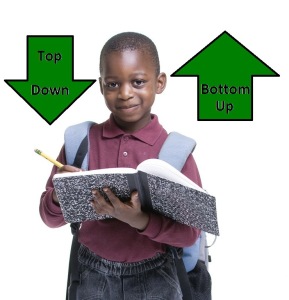 When your child is anxious or scared, he/she will tend to process information from the bottom part or primitive/survival/emotional part of his/her brain. When your child is calm and relaxed, he/she is more likely to process information from the top part of his/her brain or the frontal lobes/thinking part of the brain.
When your child is anxious or scared, he/she will tend to process information from the bottom part or primitive/survival/emotional part of his/her brain. When your child is calm and relaxed, he/she is more likely to process information from the top part of his/her brain or the frontal lobes/thinking part of the brain.
The bottom part of the brain which consists of the brain stem (survival) and limbic system (the emotional brain), does not make rational decisions. This part of the brain is ready for survival or to fight, flight or freeze. You know when this part of the brain is at work when your child lies, makes irrational choices, becomes aggressive, shuts down, acts impulsively, etc. When information is being processed in this region of the brain, information does not make it to the upper parts of the brain making it mostly impossible for the child to think clearly about what he/she is doing in the moment. In essence, the lower part of the brain “hijacks” the thinking part of the brain. Anger and fear interfere with learning and memory.
When your child processes information from the top down, your child is able to think about what he/she is doing and make better decisions. The child needs to be in a calmer state in order for this part of the brain to work optimally. This part of the brain is rational, makes decisions, is able to plan ahead, strategize, etc.
What does all this mean for parenting? When you are trying to discipline your child or teach your child a new behavior it is best to do this when the child is calm and open to absorbing information. Therefore, trying to parent your child when you are angry or when the child is anxious or upset will not lead to long-term change. When both you and your child are in a state of calmness, he/she is more likely to absorb and remember the information.
Your first step in teaching your child how to become a top down information processor is to help coregulate his/her affect/emotion. In other words, help your child learn how to manage his/her emotions with your support, patience and guidance by remaining calm and responsive when disciplining your child. When you are reactive, meaning that you approach your misbehaving child defensively, your child will sense this and the lower parts of the brain take over. When you are responsive, you are approaching your child calmly and openly in order to understand what is driving the behavior. Responding to your child this way helps your child calm down and use his/her higher cortical functions. This approach is more likely to promote an openness to learn what you are going to teach him/her.
Remember, when your child misbehaves, he/she is trying to meet a need. It is our job as parents to discover what this need is that is driving the behavior and helping the child meet this need in more appropriate and less destructive ways.
Article written by: Dr. Julie Cajolet-Eckhardt, Psy.D.
Julie is a Licensed Clinical Child Psychologist who specializes in working with children and their families and she is part of the Arizona Family Therapy Group. She helps families improve their relationships with one another and helps parents learn how to help their kids be emotionally healthy. To find out more about the services Julie provides click here or send her an email at: julie@arizonafamilytherapygroup.com
Resources:
Siegel, D.J., & Payne Bryson, T. (2011). The whole brain child. Bantam Trade Paperbacks: New York.
Siegel, D.J., & Hartzell, M. (2004). Parenting from the inside out: How a deeper understanding can help you raise children that thrive. Penguin Group: New York.
Hughes, D.A., & Baylin, J. (2012). Brain-based parenting: The neuroscience of caregiving for healthy attachment. W.W. Norton & Company: New York.
